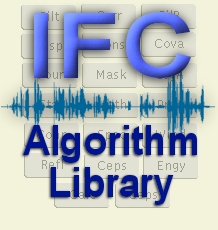3.6.1 Components:
Library Overview

We have introduced two tools, isip_transform_builder and
isip_transform, which together provide a rapid prototyping
environment for developing most standard front end algorithms. These
tools alleviate the need for users to rewrite volumes of I/O and
frame-based processing software. We hope over time that we can extend
the choices of algorithm components available in our foundation class
algorithm library.

In this section, we briefly describe the types of algorithm components
available to users. They are categorized by their scope and function:
-
Core DSP Components:
This group of components includes Cepstrum, Fourier Transform,
Spectrum, and Window, as well as more sophisticated techniques such
as linear prediction. The theory behind these components is
discussed extensively in our entry-level
digital signal processing
course. These components provide basic building blocks for
temporal and spectral analysis.
-
General Mathematics and Statistics:
These components provide basic tools for combining features
using standard mathematical (e.g, addition, subtraction,
logarithm, and other trigonometric relations) and
statistical operators (mean, variance, min, max, and median).
These are critical to the implementation of such techniques as
energy normalization.
-
Infrastructure:
These components provide two types of functions: hidden
infrastructure (e.g., AlgorithmContainer) and
programming/debugging support (e.g., DisplayData).
The components Mask and Connection are used to select and
recombine features and feature streams.
One important design consideration in the Algorithm library was the
constraint that it be easy to add new classes and new capabilities.
This is managed through a strictly controlled programming interface
documented in
AlgorithmBase.
More details on this aspect of the algorithm classes can be found in the
Algorithm library documentation.
|
